The conversion rate as the resultant of the many components of doing business is an indication of how well the goal of our digital product has been met. In other words, it is a real measure of success. Increasing the conversion rate of an e-commerce or website is therefore a goal that dreams at night for many entrepreneurs. Therefore, in this text we will discuss what the conversion rate is, what influences it and, of course, how to improve it.
Why you should increase your conversion rate
In soldierly (albeit more marketing) terms: the conversion rate is the ratio of all visits to your site to those during which a specific goal was met. The conversion rate formula thus seems fairly simple:

Calculation of the conversion rate can vary depending on the tool, metric or method you use – you can count conversions overall, or consider only the first conversion for a given user; you can consider users as unique, actual, or in terms of the number of sessions on the site.
It is customary to think of a conversion – especially e-commerce conversion – as a single event, such as correct payment information after a purchase. It is true, however, that we can think of multiple events as a conversion: filling out a form correctly, going through several points on a page, signing up for a newsletter, and so on. Each – even the smallest – optimization therefore translates into an increase in results. And the result doesn’t necessarily have to be sales.
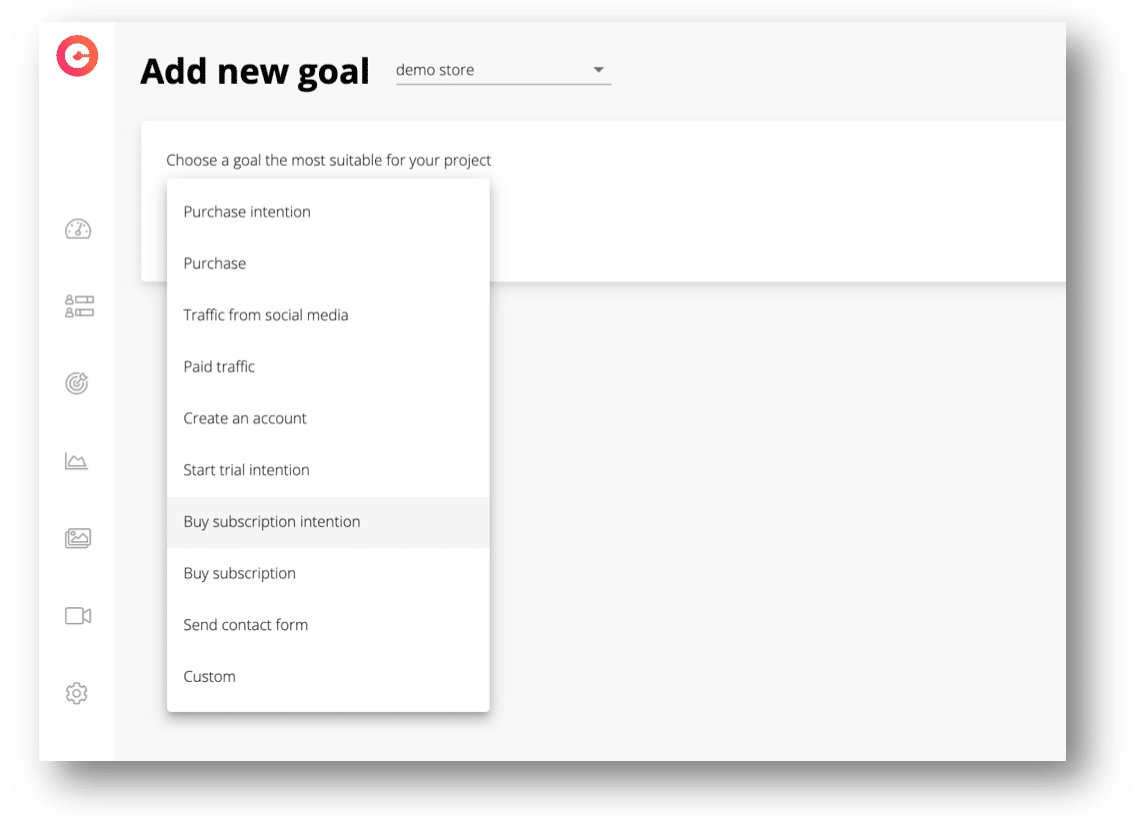
Example conversions calculated in CUX
There is usually consternation at this point: can purchase intent be considered a conversion? Of course! Let’s think for a moment – though it’s a thinking that should always accompany us – about conversion as fulfilling a goal. Correctly identifying on the user’s path the moment when we identify the purchase intention can be crucial for further optimizations. Above all, in doing so, we gain extremely important information about the potential reasons why a conversion is not happening.
An example? Here you go. Imagine that the percentage of purchase intent is very close to the percentage of conversion. What does this tell us? That the purchase process or form filling is working correctly – nothing needs to be corrected here. So our optimization work should focus on acquiring more valuable traffic or eliminating problems at earlier stages of the user journey.
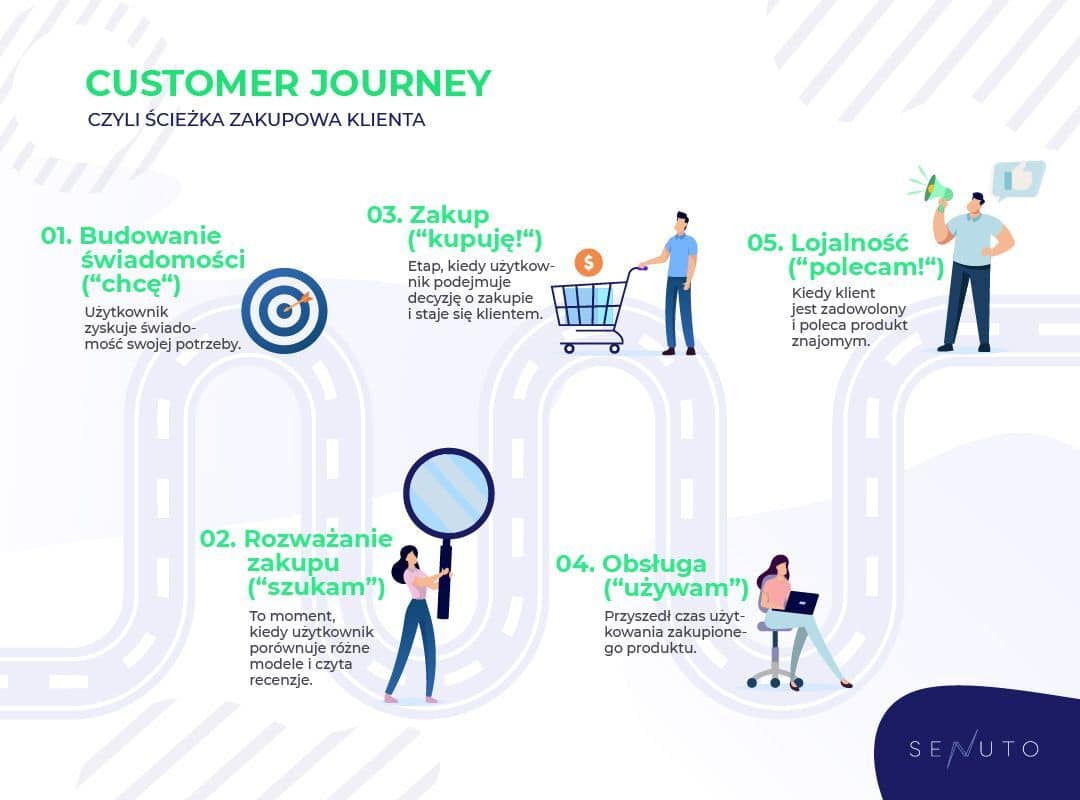
What factors affect conversion rate
It is a daunting task to identify the key aspect that directly affects the conversion rate. Even the best-designed pages or products that pull low-value traffic (visitors who do not convert) will not have satisfactory sales results.
So what affects conversion rates? A whole host of factors – from those beyond your control (like seasonality, trends or competitors’ actions) to those you can control (good UX, SEO, paid traffic).
Price, assortment or type of service and uniqueness are of course not irrelevant. In many cases – for example, when analyzing e-commerce conversion rates – they prove to be not only a key factor, but also an inescapable barrier. However, draping one’s products in a proper marketing setting allows one to find a niche for them. In such a situation, when working on increasing the conversion rate, it is worth paying attention to:
-
User experience. Research conducted by cux.io shows that even a minor frustration (such as the appearance of an unwanted pop-up or difficulty in using a particular feature) in the check-out process can drastically reduce conversion. So it’s worth ensuring a good experience.
-
Traffic Acquisition Process. It is worth focusing on analyzing traffic sources, marketing messages or the time when customers encounter our communication
-
User behavior analysis. If customers have a strong need to filter products, then prompt them with specific, select categories. If they come to the site from a social media campaign, then let’s simplify their path as much as possible – their purchases are then driven by emotions, so we need to do everything we can to make sure they don’t get sidetracked.
-
Potential product difficulties. Look out for unclear messages, lack of visible CTAs, too many product/service choices (the so-called paradox of choice), etc.
-
Potential product difficulties.
-
Automate and optimize processes. In particular: order process, payment methods, delivery time, delivery costs, etc.
In addition, the conversion rate is influenced by factors such as the scale of traffic, brand strength, UX of the website, page load time, percentage of traffic from mobile devices or website credibility.
The conversion rate is also influenced by factors such as the scale of traffic, brand strength, UX of the website, page load time, percentage of traffic from mobile devices and website credibility.
E-commerce conversion rate
When we think “e-commerce conversion rate,” we mainly think of sales or purchase intent. The goal of our optimization efforts, then, will be to make the site’s traffic valuable. Valuable, that is, traffic that will generate us as many sales, leads, newsletter signups, or other metrics that we consider as a business goal for our company.
When analyzing e-commerce conversion rates, it’s also worth leaning into correctly defining the moment when cart abandonment occurs. Why? Because users coming to your site don’t always come for a purpose that leads to a conversion. Their behavior may indicate different scenarios. Perhaps they are comparing products, checking delivery costs, or showing friends an item they have already purchased. A high rejection rate or low conversion rate for an individual visit – devoid of context – will tell us little.
Another factor that can prove crucial when it comes to e-commerce conversion rates is conversion rates across sources. Our most “go-to” analytics tool – Google Analytics – does not show the product comparison process, for example. This is because the vast majority of tools focus on analyzing conversions based on specific sessions. However, for a complete picture of user behavior, whole site visits will be important. Thus, analyzing visits instead of sessions.
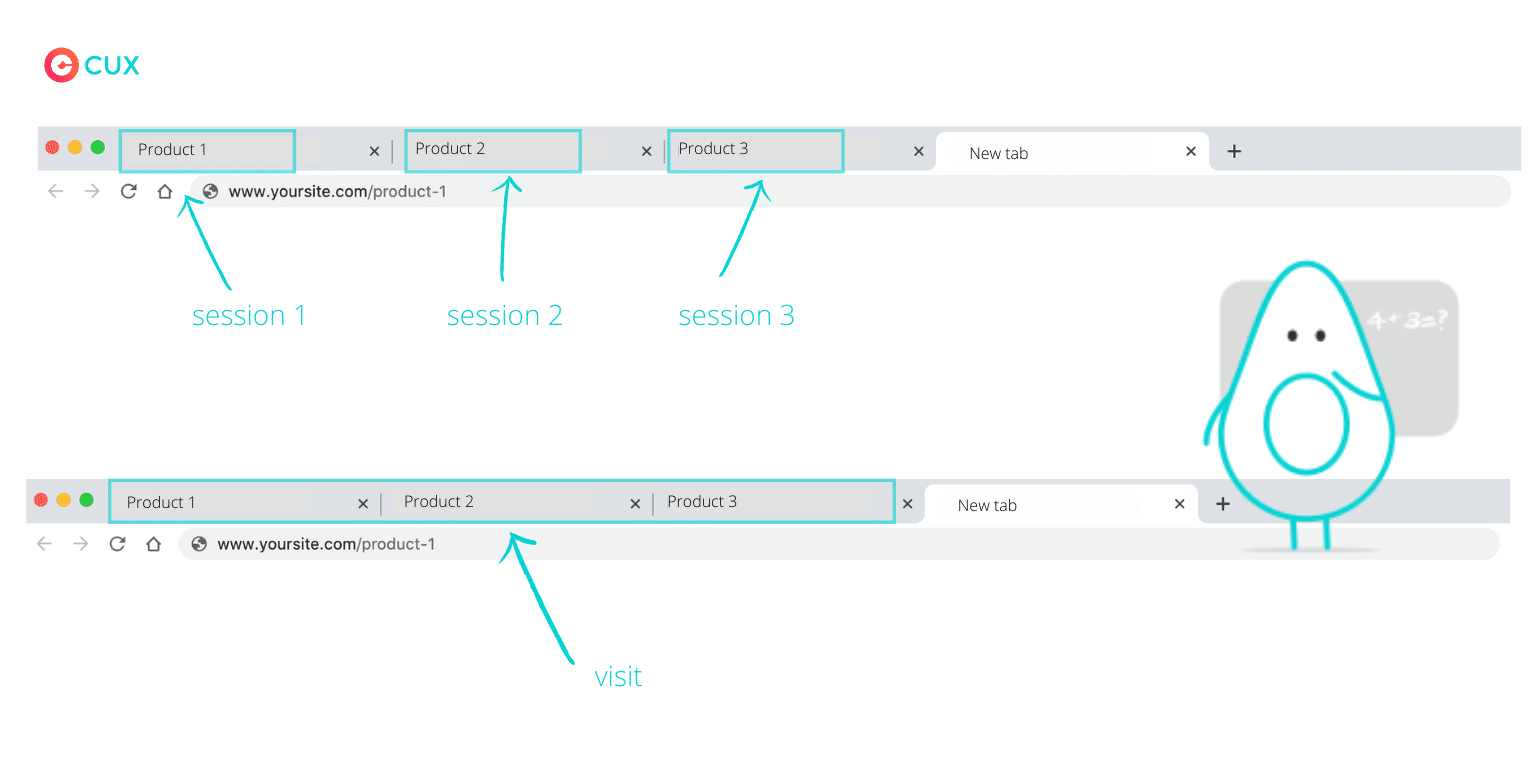
A session is only a fragment of a user’s entire visit to the site.
Conversion rate analysis in Google Analytics
Users of Google Analytics are well aware that conversions can be measured there in two ways: through goals or the e-commerce module. We consider the e-commerce conversion rate as the number of transactions divided by the number of total sessions. With that said, it is important to note that transactions can be recorded by GA more than once per session (the opposite of goals).

E-commerce conversion rate formula
Imagine that a customer visited your site 10 times. During visit #2 he bought one item, during visit #5 he bought as many as three items. So you have sold a total of four items. The conversion rate in GA would therefore look as follows:
E-commerce conversion rate (all transactions / number of sessions) = 4 / 10 = 40%.
Target conversion rate (transactions counted in sessions / number of sessions) = 2 / 10 = 20%
For many e-commerce data analyses conducted with Google Analytics, the workflow is simple: we study revenue, conversion rate and average order value. However, it is also possible to perform basic analysis using e-commerce reports to evaluate other data you collect. By using the e-commerce reports available in GA, you can:
- track conversion rates and average order value,
- check the effectiveness of the campaign,
- evaluate the strengths and weaknesses of the purchase path and transaction path,
- examine the effectiveness of the products and the product list,
- analyze conversions, which include product coupon codes and orders, as well as conversions resulting from affiliate marketing,
- Test the effectiveness of the product list and product list,
In addition to meeting the goals or conversions themselves, it can be very useful toanalyze the conversion funnel. In this case, the best solution will be to follow the principle of “from general to specific“. So we set up a basic customer path and check where the biggest drop-off occurs. We modify the path. Then we again narrow down the analysis to the hot spot.
.
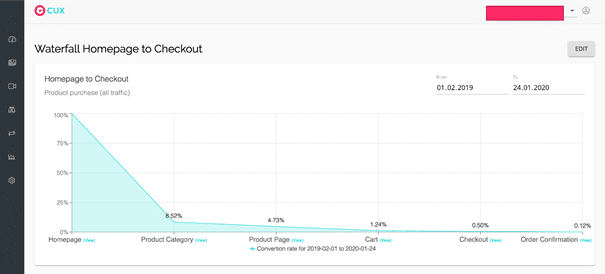
Full view of the customer path (Conversion Waterfall) in CUX – from homepage to checkout.
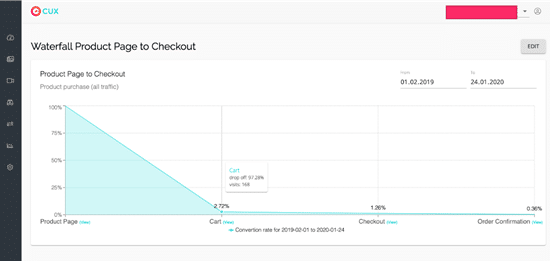
Tightening the path to the point of greatest decline – Conversion Waterfall from Product Page to checkout.
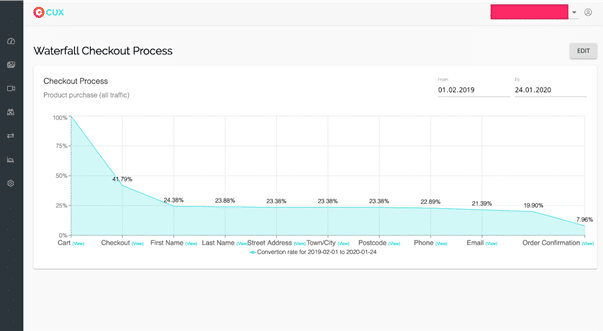
The narrowest customer path image – Conversion Waterfall from shopping cart to checkout.
Naturally, the desire to work on the last steps of the funnel is awakened. Keep in mind, however, that if the numbers show similar values, small drops or negligible conversions, we won’t do anything by sealing those last steps. To see results, we need to start looking a little earlier – at the campaign stage, traffic acquisition or on the path to the site.
To be sure what specifically didn’t work on the path to conversion and to find solutions tailored to the target audience, it’s worth analyzing user behavior recordings for each moment of a big drop. In this way, we will be able to answer what exactly was the obstacle for our customers. So instead of fortune-telling, we will implement optimization perfectly tailored to the needs of our target group.
How to improve conversion rate
The level of conversion rate depends largely on the quality of the acquired traffic. Therefore, the first step to increase conversions should be to eliminate low-quality traffic on our site..
First of all, we should focus on knowing and keeping up with our own target audience. This is not a category given to us once and for all! Our customers and their needs change, and only keeping our hand on the pulse will allow us to respond to these changes immediately. This will be helped by observing behavior from campaigns, reconstructing user paths from individual traffic sources, and comparing those paths that succeeded with those that did not reach the target.
Remember to not focus too much on eliminating bottlenecks only at the end of the customer path. The customer journey should be looked at holistically and treated as a goal. So let’s focus on eliminating obstacles along entire paths and verifying to what extent the people who travel that path are the ones who are likely to complete it.
Increasing conversions is a multi-pronged activity, so different procedures will work well for different types of business. Measures to raise conversion rates in B2B, SaaS or online stores will vary. However, the basics include website optimization, UX, SEO, building trust and recognition or content marketing.
What does lowering the conversion rate lead to?
To a decrease in our earnings, of course! Conversion rate – in addition to our intentional actions – can also be affected by external situations beyond our control. A pandemic, a periodic reduction in product demand, a change in trends, etc.
So what does a reduced conversion rate tell us about?”
It can be information about, among other things:
-
-
the exhaustion of a given advertising formula,
- about technical problems,
-
changing needs of the target group,
-
How much should the conversion rate be
What conversion rate is good? In UX terms: it depends. In truth, it’s impossible to answer this question unequivocally. In some situations, the conversion rate can reach over 100%, in others 180% (e.g., for price comparison sites that redirect users to external sites), and in others a few to several percent.
Conversion optimization is an ongoing process that consists of several steps. We start by setting up analytics and conducting qualitative and quantitative analyses. Then we look for hypotheses for A/B testing. We test the changes and check the results to finally repeat the whole process from the beginning.
What we can do is look at individual case studies from our industry and observe the values in the market. It is true, however, that first and foremost, you need to watch the conversion rate trend in your own business.
 Kamila Kotowska
Kamila Kotowska